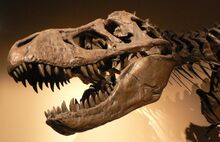Biology:Paleomycology
From HandWiki
Short description: Study of organic evolution of fungi based on fossils
| Part of a series on |
| Paleontology |
|---|
 |
|
Paleontology Portal Category |
Paleomycology is the study of fossil fungi.[1] A paleomycologist is someone who works in this field. Paleomycology is considered a subdiscipline of paleobotany.[2] While most fossils of mushrooms are discovered in amber,[3] a great diversity of fossil fungi have been documented throughout the Phanerozoic.[4][5]
See also
References
- ↑ Brown OLM (2004). "Fossil fungi or paleomycology" (in Spanish). Interciencia 29 (2): 94–98.
- ↑ Taylor, Thomas N.; Taylor, Edith L.; Krings, Michael (2009). Paleobotany: The Biology and Evolution of Fossil Plants, Second Edition. Boston: Academic Press. p. 98. ISBN 978-0-12-373972-8. https://books.google.com/books?id=_29tNNeQKeMC&q=Paleomycology&pg=PA98. Retrieved 2010-01-15.
- ↑ Layton, Christine. "Paleomycology: Discovering the fungal contemporaries of dinosaurs". Cornell University. https://blog.mycology.cornell.edu/2009/05/13/paleomycology-discovering-the-fungal-contemporaries-of-dinosaurs.
- ↑ Kalgutkar, R. M., and J. Jansonius. 2000. Synopsis of fossil fungal spores, mycelia and fructifications. American Association of Systematic Palynologists Contributions Series 39: 1–423.
- ↑ "The Kalgutkar and Jansonius Database of Fossil Fungi". https://advance.science.sfu.ca/fungi/fossils/Kalgutkar_and_Jansonius/index.php?-link=Home.
 |

